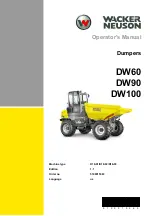
.
ATTACHMENTS AND OPTIONS
ATTACHMENT GUIDE
SELECTION OF TRACK SHOES
Select the most suitable track shoe to match the operating conditions.
METHOD OF SELECTING SHOES
Check the category from the uses in the table below, then select the shoes from the table below that.
Category of use B is the wide shoe, so there are limits on the use. Check the precautions for use, examine the
conditions of use thoroughly, and use the optimum shoes for the situation.
When selecting the shoe width, choose the narrowest shoes possible to bring the machine within the range
where there is no problem regarding the machine flotation and ground contact pressure. If wider shoes than
necessary are used, the load on the track shoe will increase, so this may cause problems such as bending of
the shoe, cracking of the link, damage of the pin, and looseness of the shoe bolts.
Category
Use
Precautions when using
A
Rocky ground,
riverbeds, normal soil
On rough ground with large obstacles such as boulders or fallen trees,
travel at low speed.
B
Normal soil,
soft ground
These shoes cannot be used on rough ground where there are large
obstacles such as boulders or fallen trees.
Travel at high speed only on flat surfaces. If you have to travel over an
obstacle, travel slowly in low speed.
C
Paved road surfaces
To protect the road liner and the rubber shoe, always obey the precautions
in Section "ROAD LINERS AND RUBBER SHOES(3-110 PAGE)".
PC78MR
Specifications
Category
Standard
450 mm (17.7 in) Triple
A
Option
600 mm (23.6 in) Triple
B
Option
450 mm (17.7 in) Road Liner
C
Option
450 mm (17.7 in) Rubber shoe
C
6 - 11
Summary of Contents for PC78MR-6
Page 2: ... 1 1 ...
Page 4: ... FOREWORD FOREWORD 1 3 ...
Page 5: ... FOREWORD FOREWORD 1 4 ...
Page 15: ... ...
Page 16: ... 2 1 ...
Page 20: ... SAFETY SAFETY LABELS LOCATION OF SAFETY LABELS 2 5 ...
Page 55: ... ...
Page 56: ... 3 1 ...
Page 195: ... ...
Page 196: ... 4 1 ...
Page 271: ... ...
Page 272: ... 5 1 ...
Page 275: ... ...
Page 276: ... 6 1 ...
Page 294: ... ...






























